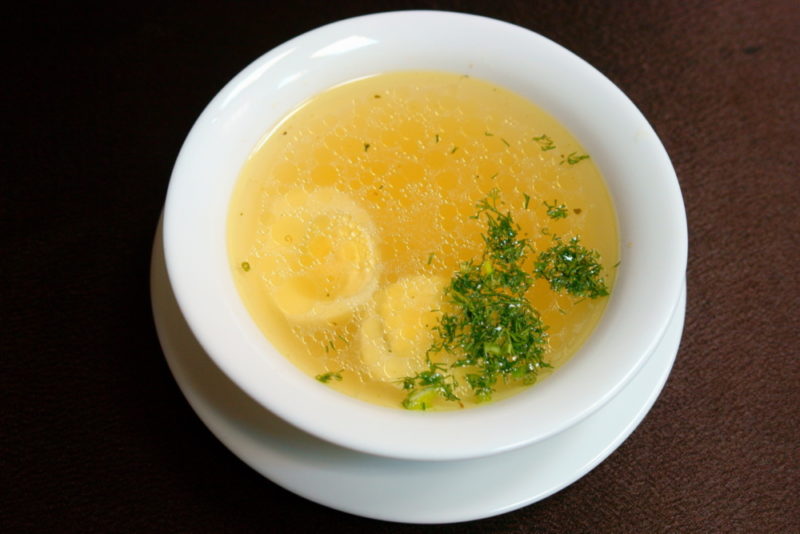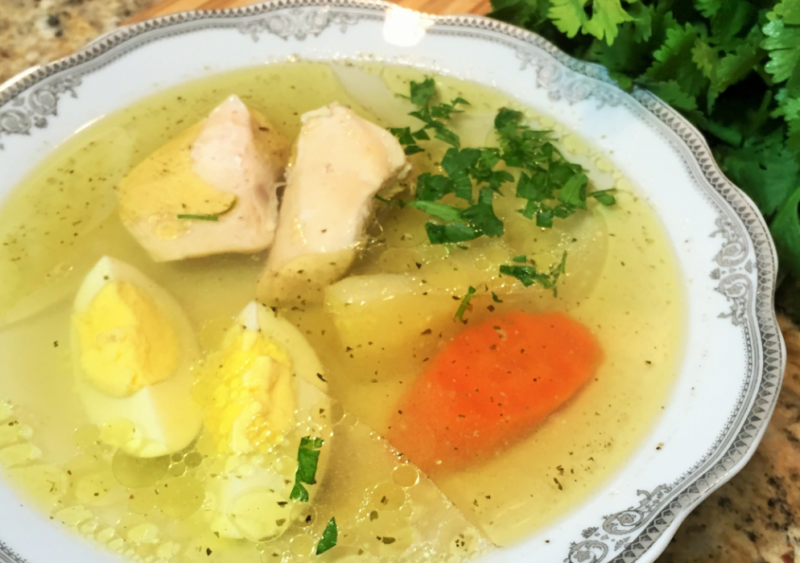Liquid decoctions of poultry meat are popular both as an independent dish, and the basis for soup, borsch. To find out how many calories are in chicken broth, many people are losing weight. The product is very useful, even has medicinal and preventive properties, but if improperly prepared, it can add a few centimeters at the waist.
Material Content:
Chemical composition and nutritional value
Chicken broth is most commonly used in diet foods. Poultry meat is accessible to all segments of the population, easy to digest, and has high nutritional value. After cooking chicken without salt, spices and vegetables, a certain set of substances passes into the water.
Only 100 grams of chicken broth contains about 4 g of protein. Aspartic acid, lysine, leucine, arginine, isoleucine, alanine, and valine predominate in the amino acid composition. The protein molecules contained in the fillet (another part of the carcass) denature when heated, partially pass into the broth, and are easier to absorb by the body.
Poultry meat contains mainly protein, and very little connective and adipose tissue is also present.
Offal, wings, legs can be used to make rich soup, borscht. However, in the broth from such parts of the chicken there is a small protein, low nutritional and dietary properties of such a decoction are noted.
Fat in chicken stock - about 3 grams. The main part of lipids is concentrated under the skin, and in a lean chicken it is only 5%. The composition is dominated by useful for the body fatty acids: saturated, monounsaturated and polyunsaturated. If the chicken is old, then this component is more, and the composition is less favorable for human health.
Carbohydrates in chicken broth - from 0.3 to 0.4 g.These are mainly mono- and disaccharides, starchy substances.
Vitamins in 100 g of broth:
- A - 0.01 mg;
- B1 - 0.06 mg;
- B2 - 0.17 mg;
- B6 - 0.35 mg;
- pantothenic acid - 0.16 mg;
- C - 0.99 mg;
- E - 0.3 mg.
Chicken broth contains a wide variety of mineral components. The number of macro- and micronutrients depends on nutrition, walking, poultry breed.
Mineral components (per 100 g of chicken stock):
- potassium - 190 mg;
- phosphorus - 178 mg;
- sodium - 100 mg;
- magnesium - 30 mg;
- calcium - 11 mg;
- iron - 1.4 mg.
The chemical composition and nutritional value of the broth depends on the volume of water in which the whole carcass or only part of the chicken was boiled, the age of the bird, cooking with or without skin, and other conditions. It is acceptable to focus on average indicators.
Calorie content and BJU chicken broth
Energy value can be determined by adding the calorie content of the ingredients of the broth and dividing by the weight of the entire solution. Often use the simplified formula proposed by nutritionists. You need to multiply the energy value of chicken in the liquid component of the dish by a factor of 0.9. The most accurate value is obtained if water and meat are taken in equal proportions.
When boiling 1 kg of chicken legs in 1 liter of drinking liquid, a meal with a calorie content of about 176 kcal (per 100 g) is obtained. The same indicator for fillets is about 102 kcal. The body gets so much energy if you eat the broth with poultry meat.
To determine the calorie content of chicken broth, the same meat index after cooking should be subtracted from the energy value of the raw component. Next, you need to multiply the obtained value by the mass of the product divided by the weight of the water taken for the broth. Or from the calculated calorie content, along with meat, subtract the energy value of the finished fillet.
For broth from chicken hams, the figure is about 10.5 kcal. The calorie content of such food prepared from a piece of meat without pits is 7 kcal (per 100 g of product). The energy value of 100 g of the liquid component from various parts of the chicken varies from 7 to 68 kcal. Proteins account for an average of 33%, fats - up to 65%, carbohydrates about 3% of calories.
Daily intake
When eating 100 g of chicken broth, the body receives 5.3% of the daily protein intake, 5.6% of fats and only 0.2% of carbohydrates. How much to drink a healthy decoction of poultry meat depends on the desired satiety of nutrition. You can focus on an average of 50 kcal / 100 g. This amount of product will provide the body with 2.6% of the daily norm (2000 kcal).
Ways to Reduce Calories in a Product
The energy value of the broth can be reduced in many ways. It is enough to remove the skin and subcutaneous fat from the carcass or part thereof. 20 minutes after the start of boiling, the first water should be drained along with the foam, rinse the meat under running water. Then you can cook until cooked.
There are several culinary rules to keep in mind. To get a delicious broth, fillets or other parts of the carcass are dipped in cold water. To ensure the maximum taste of poultry meat, the processed portion is dipped in boiling water. A piece of onion along with the husk is added to the broth to lighten, reduce fat content, give the dish a more beautiful color.
When boiled for a long time, the chicken fillet turns out hard to taste. And also it is not recommended to heat the meat on the bone for too long. Gelatin is secreted from the joints, and jelly is obtained.
The benefits of losing weight
The product can be consumed by those who seek to reduce the energy value of food without compromising the protein, vitamin and mineral components of the diet. The smallest calorie portion of the chicken is fillet. This product is best for diet. A decoction of chicken breast, even on bones and with skin, is less rich in fat than a whole carcass.
A satisfying and low-calorie product is useful for losing weight. The broth can be used as a first course, satisfying hunger and not harming the figure.The body receives amino acids, fatty acids, vitamins and minerals, but not an excess of calories.















